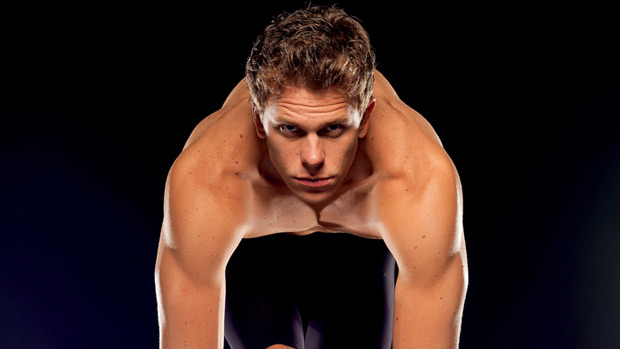The generation of speed swimmers, like Cesar Cielo, achieved spectacular times with the help of uniform science – in 2012, they want to prove that the second skin is a mere detail

This article is part of VEJA magazine special English issue about the London Games.
» Learn how to download the complete edition here

Cesar Cielo of Brazil, gold medal in the 50-meter and bronze in the 100-meter freestyle events in Beijing, is the fastest man in the world in a swimming pool. In 2009, he broke the world record for the 100-meter (time of 46s91) and 50-meter (20s91) events. These times are still records, but conditions have changed. When he gets in the pool in London, Cielo will not have the help of the super swimsuits – the technological suits were banned by the International Swimming Federation in January 2010. The second skin enabled the athlete to float with more ease by increasing muscle compression and reducing the body’s resistance to water. At the time, several specialists indicated it would be very difficult to see the athletes beat the 91 world records obtained just with the LZR Racer model, the Ferrari of super swimsuits.
Indeed, banishing technological help put a lid on the unbridled production of records. Thus far – two and a half years later – only two records were broken: the men’s 1500-meter freestyle and the men’s 200-meter medley. But the prohibition also had a positive effect by determining who’s who in the swimming elite. Only the super athletes like Cielo have been able to exchange the technological advances of synthetic fabrics with raw performance, using chest and arms. These champions are beginning to produce results approaching the times of the swimsuit era. It is a beautiful parable for swimming; a return to the time when a champion like the mustachioed American Mark Spitz, seven gold medals in Munich (1972), wore nothing but a simple pair of swimming trunks. Today, swimmers wax, which subtracts a few thousandths of a second from the final result. Thus, in London, we will see hairless swimmers – but without the full body suits. This is a phenomenon that, naturally, also occurs with the women.

Cielo has a huge challenge in the Olympics, which represents the start of a new era or a return to the old days. With the support of the Brazilian Swimming Team’s technical analyst, biomechanic Paulo Cezar Marinho, the athlete intensified some innovative training, which he had been doing since 2004, adapted from the techniques of Russian Yuri Verkhoshansky, who became famous in the 1980s by developing a training method based on jumps. Paulo Cezar created a period system in specific blocks for swimming. This method is divided into three micro cycles and enables the athlete to achieve three peaks of excellence in competition during the year. “In the preparatory period, the emphasis is on strength training, both in and out of the water. In the pre-competition phase, physical conditioning is maintained, but the focus falls on movement speed. A few days before the event, the objective is to simulate the competition situation in practice”, says Paulo Cezar.
The improvement work also has a pre-competition phase. Equipped with video cameras and editing equipment, the technical team analyzes the Brazilian swimmers’ practices and competitions and compares them to their adversaries. Paulo Cezar divided the 50-meter freestyle into five segments: entry, underwater kick, breakout, clean swim and finalization. From this analysis, the team found out the Olympic champion had to fine tune the breakout, the transition between the underwater kick and the crawl. From exiting the block to starting the crawl, a swimmer can have up to 20% of the event’s whole distance, and Cielo could lose precious hundredths of a second due to lack of explosion. In the case of Bruno Fratus, the Brazilian athlete who also participated in the analysis work, the main problem was the first few meters after exiting the block. With specific training, Fratus, who after the dive would take his first strokes 8.68 meters from the edge of the pool at the 2001 Maria Lenk Trophy, began to do so at 9.27 meters in the same competition this year. “I never trained my athletes so little, but the results improved, because now the training is done with more science”, says Arilson Silva, Bruno Fratus’ coach. Normally, athletes swim from 30 to 35 kilometers per week in the final preparation period before major competitions. Cielo and Fratus swim a much lower volume, between 15 and 20 kilometers per week.

Another strategy adopted by the team is to tinker with the athlete’s physiology. The swimsuits used to provide greater floatability, which facilitated progression in the water. The Olympic champion underwent a special diet to alter fat composition in the body and reach a natural floatability condition similar to that provided by the swimsuits. When he won the gold in Beijing, Cielo had 13% of body fat. For the London Olympics, the doctor Gustavo Magliocca estimates he will be at 9% to 10%. Furthermore, over the past two years, the athlete gained 2 kilos of muscle mass, which means more strength.
The preparation provided results. This season, Cielo had the best time in the 50 meters, 21.38 seconds, very near the 21.30 seconds that earned him the gold in Beijing. “In London, he should finish it between 20.90 and 21.03 seconds”, says Alberto Silva, the swimmer’s coach. This must clearly be arranged with his opponents. Fratus himself is a threat, holder of the fourth best time in 2012. The American Cullen Jones is another one. He had the second best time of the year, 21.59 seconds. In the 100 meters, the biggest threat is James Magnussen, 21, from Australia. He holds the best post-prohibition time, 47.10 seconds. Cielo was unable to swim under 47.84 seconds. It won’t be easy to come back from London with two gold medals.
